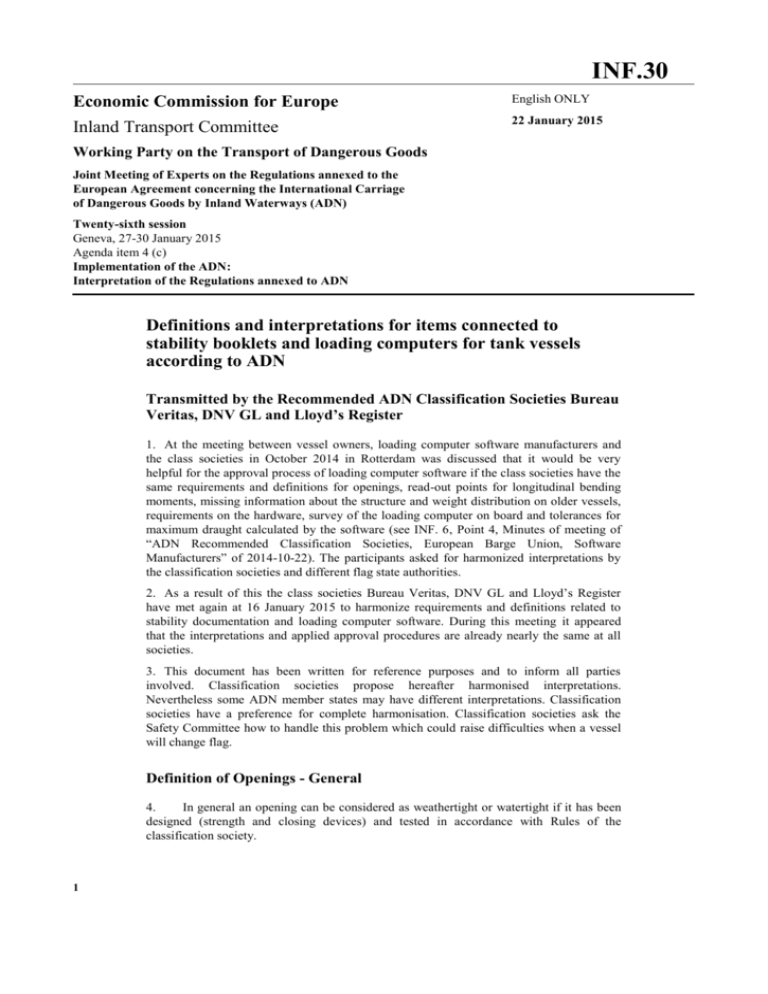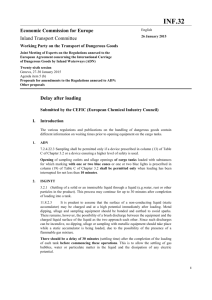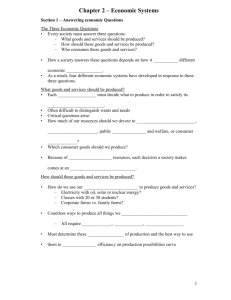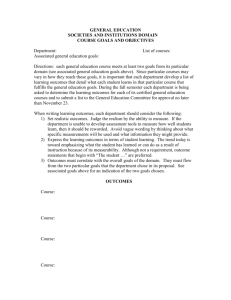Definitions and interpretations for items connected to stability
advertisement

INF.30 Economic Commission for Europe English ONLY Inland Transport Committee 22 January 2015 Working Party on the Transport of Dangerous Goods Joint Meeting of Experts on the Regulations annexed to the European Agreement concerning the International Carriage of Dangerous Goods by Inland Waterways (ADN) Twenty-sixth session Geneva, 27-30 January 2015 Agenda item 4 (c) Implementation of the ADN: Interpretation of the Regulations annexed to ADN Definitions and interpretations for items connected to stability booklets and loading computers for tank vessels according to ADN Transmitted by the Recommended ADN Classification Societies Bureau Veritas, DNV GL and Lloyd’s Register 1. At the meeting between vessel owners, loading computer software manufacturers and the class societies in October 2014 in Rotterdam was discussed that it would be very helpful for the approval process of loading computer software if the class societies have the same requirements and definitions for openings, read-out points for longitudinal bending moments, missing information about the structure and weight distribution on older vessels, requirements on the hardware, survey of the loading computer on board and tolerances for maximum draught calculated by the software (see INF. 6, Point 4, Minutes of meeting of “ADN Recommended Classification Societies, European Barge Union, Software Manufacturers” of 2014-10-22). The participants asked for harmonized interpretations by the classification societies and different flag state authorities. 2. As a result of this the class societies Bureau Veritas, DNV GL and Lloyd’s Register have met again at 16 January 2015 to harmonize requirements and definitions related to stability documentation and loading computer software. During this meeting it appeared that the interpretations and applied approval procedures are already nearly the same at all societies. 3. This document has been written for reference purposes and to inform all parties involved. Classification societies propose hereafter harmonised interpretations. Nevertheless some ADN member states may have different interpretations. Classification societies have a preference for complete harmonisation. Classification societies ask the Safety Committee how to handle this problem which could raise difficulties when a vessel will change flag. Definition of Openings - General 4. In general an opening can be considered as weathertight or watertight if it has been designed (strength and closing devices) and tested in accordance with Rules of the classification society. 1 INF.30 5. For weathertightness the component has to be tested: for one minute when they are subjected to a pressure corresponding to a 1 m head of water, or for ten minutes when they are exposed to the action of a jet of water with a minimum pressure of 1 bar in all directions over their entire area. 6. Watertight: designates structural elements or devices which meet all the conditions stated for weathertightness and also remain tight at the anticipated internal and external pressure. 7. Watertightness should be proven by workshop testing and where applicable by type approvals in combination with construction drawings (e.g. watertight sliding doors, cable penetrations through watertight bulkheads). Ventilation openings with included fire valve 8. These kinds of openings have to be considered as“open” type of opening. 9. It is understood that it concerns engine room ventilation and other ventilation, including those equipped with a fire damper. Gooseneck with limited diameter 9. This kind of opening has in general to be considered as “open” type of opening. Goosenecks or other similar vent pipes having a transverse area ≤ 710 mm² could be considered as "weathertight" in the stability software. The quantity of water entering would be negligible if these kinds of openings are underwater for a short time only. On board existing vessels and for vessels still under construction (until 31 December 2015), goosenecks or other similar vent pipes having a transverse area ≤ 7850 mm² (diameter, 100 mm) may be considered as "weathertight" in the stability software. Gooseneck with unlimited diameter 10. This kind of opening has to be considered as “open” type of opening. Closable gooseneck 11. From the safety point of view for the tank structure and for operational matters class societies decided that this kind of opening is not allowed. Aluminum door to accommodation 12. A door without any test has to be considered as “open” type of opening. In case the door is tested according class rules as weathertight or watertight it can be considered as a “weathertight” or “watertight” type of opening, independent from the used material (not limited to aluminium). 2 INF.30 Aluminum door to accommodation demonstrated by a spray test 13. This type of door can also be considered as weathertight and even as watertight if designed and tested according to class rules. Applicable for any kind of construction (not limited to aluminium). Aluminum full glass door with certificate for water tightness 14. If the door is tested according to class rules it can be considered as weathertight and even as watertight if designed and tested in consequence. Applicable for any kind of construction (not limited to aluminium). Doors and hatches with rubber and clamps 15. If doors and hatches are tested according to class rules they can be considered as weathertight and even as watertight if designed and tested in consequence (see general note above). Applicable for any kind of construction. Fixed windows complies with article 4.5 of the decree of he Netherlands for passenger vessels 16. If the windows are tested according to class rules they can be considered as “weathertight”. 17. However if windows are arranged below the weatherdeck they have to be designed as watertight and have to be in compliance with ISO 3903, non-opening type, heavy type (amongst other, strength test 75kPa). Windows with the possibility to open 18. This type of window has to be considered as an “open” type of opening. However if the windows are partly non-opening type, then the lower part could be considered as watertight if designed and tested as such. Chain pipe to chain locker 19. This type of opening has to be considered as an “open” type of opening also if the upper part of the chain pipe will be closed with a closing device like a steel plate or so. Winel / Winteb automatic closing device (with a floating ball) 20. Class societies consider this type of devices as “weathertight” if they are tested according class rules. 21. However it is also known that for vessels which receive an approval certificate from the Netherlands, the administration has informed that these kinds of openings can be considered as watertight (see Instruction to RO no. 1. Stability for inland waterway ships Version def April 2011, §1.5). It is understood that the Netherlands authorities would consider that ingress of water would be negligible if such kind of opening is submerged. 3 INF.30 22. From now on the Classification Societies will consider this type of device as “weathertight” and will no longer take into account the interpretation of the Netherlands authorities (paragraph 21). For existing vessels and for vessels still under construction (until 31 December 2015), this type of device may be considered as watertight. The seal between the weather deck and the flexible mounted accommodation 23. The seal has been assumed watertight. Watertightness should be ensured. If this is not the case, this would lead to major issue with damage stability for a lot of vessels (safety distance 0.1m at final stage of flooding). This kind of seal has to be hose tested at each class renewal. 24. In case the engine room is flooded, the deck house boundary with the engine room can be considered as watertight if the deck house bottom and walls as well as the boundary elements have sufficient strength and are shown watertight. Read out points for longitudinal strength • SIMPLE CURVE of maximum bending moments 25. The group has decided to use in general the following simple curve for the definition of maximum stillwater Hogging and Sagging moment curve if no additional calculations are requested by the owner. It has been decided that Shear forces for inland waterway tank vessels in general are at such a low level that they can be disregarded for the loading computer software. The simple curve can be used when the stability booklet is used. Classification societies consider using the proposed simple curve in general, but each classification society has the right to adapt this curve when she indicates insufficient longitudinal strength for a vessel at the transitional areas between cargo part and fore and / or aft ship parts. • 4 OPTIMIZED CURVE of maximum bending moments INF.30 26. On the request of the owner a more optimized curve for the maximum allowable Hogging and Sagging moments can be defined on the basis of real existing transverse sections and calculations for all relevant sections. How to proceed with older vessels without sufficient information in the actual stability booklet 27. It was discussed that it can be expected that quite some stability booklets approved in the past by administrations or class societies do not fulfil the actual requirements of the ADN Regulations. The main points with regard to this are: Missing openings (damage control plan) Missing of some damage stability criteria Missing of damage conditions / damage stability load cases Language of the stability booklet according ADN Regulations 28. As mentioned in the ADN regulations, the loading instrument must “contain the contents of the stability booklet”. In the opinion of the group, if the stability booklet is not relevant or does not contain sufficient information, then the first step has to be the approval of an updated or new version of the stability booklet and then to approve the loading instrument, based on an approved stability booklet. An additional annex with missing information would also be acceptable. 29. For older vessels without any approved stability documentation the documentation of the loading instrument has to be adjusted to such an extent that all relevant information is available. Hull data like lines plan or offset table might also be included here. Marinised type-approved hardware 30. ADN recognised class societies have decided at a former meeting that they do not require a marinised computer. One computer for the installation of the software is sufficient. On-board verification of test conditions 31. For class societies the check of correct working of the software on board is essential for the vessel’s safety. In addition, it is necessary that it can be clearly identified which version of the software is approved and that changes or modifications of software have to be indicated to the class society. Therefore the group requests a clear Software Identification Number for each vessel. From class societies’ point of view checking of the test conditions in the office only is not acceptable. Maximum draft 32. One loading computer software manufacturer explained problems of their software program with the limitation of maximum draft values. It was discussed, that in general the limits must not exceed the maximum draught for all draught marks. But in this special case 5 INF.30 it should be possible, that for the fore and aft marks the master can verify the real existing draught marks against the draught marks calculated by the loading computer for a maximum deviation of 5 cm. That means in case the real viewed value at the ship hull is lower than the calculated one it should be allowed for the master to put into the program the real value as a basis for the acceptance of the load case at the loading computer. This is not allowed if the program calculates the maximum draughts by considering an automatic calculated hull deflection. A final procedure for this has to be submitted to each class society involved. Filling grade engine room 33. With regard to the permeability of machinery spaces the group decided that if a value smaller than 95% will be used it has to be demonstrated by calculations (also for the minimum value of 85%). 34. For older vessels with an already approved stability booklet a used permeability of 85% is acceptable. Exhaust pipes leading through the outer shell 35. Exhaust pipes leading through the outer shell have to be mentioned in any case in the list of non-watertight openings. They should be considered case by case, depending on the installation and design of the exhaust system. Several cases can exist: exhaust pipe fitted on side shell or transom, fitted with non-return valve or lyre (or loop), wet exhaust system, etc. In case of lyre without non-return valve, the highest flooding point of the exhaust pipe should be considered as a non-weathertight opening. General requirements for loading computer software 36. The group decided that each loading computer software for tank vessels according to ADN Regulations has to be provided with a warning for the maximum filling level of cargo tanks. 37. The class societies DNV GL, BV and LR do not insist (as prescribed by the ADN) to include in the loading and stability manual: - Bilge and Ballast system plans - Overflow prevention system diagram. 38. This is because the purpose of including these in the manual is not understood. ______________ 6








